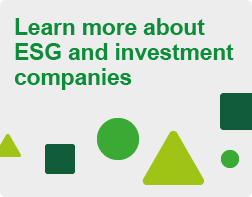ESG Policy
Our Approach
Sustainable dividend growth has always been our investment mantra and has been the Company’s guiding light for the past ten years. To achieve this sustainability, companies have to be cognisant of all threats including those that are environmental, social or related to poor governance (ESG). Successful companies, and investors, have increasingly been on guard against these threats in recent years even if they might not have grouped them into such a tidy acronym. Companies that have flouted good ESG principles, from the East India Company to Wirecard, usually meet their comeuppance although it is hard to predict the exact timing of their demise.
Fidelity’s introduction of ESG scores has helped us to sharpen our focus in this area and question why we continue to hold companies that score less well through an ESG lens. We will remain pragmatic and not dogmatic and will continue to engage with our invested companies to understand their strategy and actions regarding ESG factors. Given the Company’s long held focus on sustainability, it will not surprise you that, on average, the Company scores well on ESG factors although there may well always be individual exceptions which are scrutinised and assessed holistically and thoroughly on an on-going basis.
Investment process
Fidelity has embedded Environmental, Social and Governance (“ESG”) factors in its investment decision making process. Fidelity has been a signatory to the United Nations Principles for Responsible Investment (UNPRI) since 2012 and submits an annual report detailing how it incorporates ESG into its investment analysis.
ESG integration at Fidelity International is carried out at the fundamental research analyst level within its investment teams, primarily through the implementation of the Fidelity Proprietary Sustainability Rating. This rating was established in 2019 and is designed to generate a forward-looking and holistic assessment of a company’s ESG risks and opportunities, based on sector specific key performance indicators across 99 individual and unique sub-sectors. A breakdown of the ratings of the companies in the portfolio using MSCI and Fidelity’s own proprietary ratings is on page 9. In addition, Fidelity’s portfolio managers are also active in analysing the effects of ESG factors when making investment decisions.
Fidelity’s approach to integrating ESG factors into its investment analysis includes the following activities:
• In-depth research
• Company engagement
• Active ownership
• Collaboration within the investment industry
Although Fidelity’s analysts have overall responsibility for analysing the environmental, social and governance performance of the companies in which it invests, it has a dedicated Sustainable Investing Team working closely with the investment teams and is responsible for consolidating Fidelity’s approach to stewardship, engagement, ESG integration and the exercise of its votes at general meetings.
The Sustainable Investing Team have a key role in assisting the investment teams with ESG integration which includes:
• Implementing Fidelity’s proxy voting guidelines.
• Engagement with investee companies on ESG issues including attending company meetings.
• Working closely with the investment team globally across all asset classes in integrating ESG into analysis and decision-making.
• Providing internal ESG reporting including analyst reports, portfolio manager reviews and industry analysis.
• Co-ordinating and responding to specific client queries on ESG topics.
• Publishing client reporting on ESG integration and proxy voting.
• Maintaining a thorough understanding of current ESG themes and trends around the world.
• Attending external seminars and conferences focusing on trending ESG issues and ESG integration.
• Providing ESG training to the investment team and across the business.
Fidelity’s investment approach involves bottom-up research. As well as studying financial results, the portfolio managers and analysts carry out additional qualitative analysis of potential investments. They examine the business, customers and suppliers and may often visit the companies in person to develop a view of every company in which Fidelity invests and ESG factors are embedded in this research process.
Examples of ESG factors that Fidelity’s investment teams may consider as part of its company and industry analysis include:
• Corporate governance (e.g. Board structure, executive remuneration)
• Shareholder rights (e.g. election of directors, capital amendments)
• Changes to regulation (e.g. greenhouse gas emissions restrictions, governance codes)
• Physical threats (e.g. extreme weather, climate change, water shortages)
• Brand and reputational issues (e.g. poor health and safety record, cyber security breaches)
• Supply chain management (e.g. increase in fatalities, lost time injury rates, labour relations)
• Work practices (e.g. observation of health, safety and human rights provisions and compliance with the provisions of the Modern Slavery Act)
Fidelity operates analyst training and development programmes which include modules on ESG themes, topics and strategies and attendance at external seminars on the trending ESG issues in the market globally as well as conferences to explore new ways of integrating ESG into the investment process across all asset classes.
Fidelity uses a number of external research sources around the world that provide ESG-themed reports and it subscribes to an external ESG research provider and rating agency to supplement its organic analysis. Fidelity receives reports that include company specific and industry specific research as well as ad hoc thematic research looking at particular topics. The ESG ratings are industry specific and are calculated relative to industry peers and Fidelity uses these ratings in conjunction with its wider analysis. Fidelity’s sources of ESG research are reviewed on a regular basis.
The ESG ratings and associated company reports are included on Fidelity’s centralised research management system. This is an integrated desktop database, so that each analyst has a first-hand view of how each company under their coverage is rated according to ESG factors. In addition, ESG ratings are included in the analyst research notes which are published internally and form part of the investment decision. The external research vendor also provides controversy alerts which include information on companies within its coverage which have been identified to have been involved in a high-risk controversy that may have a material impact on the company’s business or its reputation.



